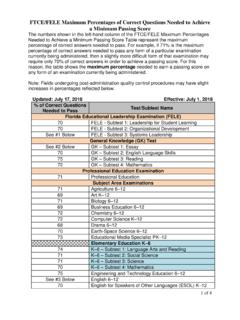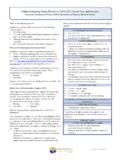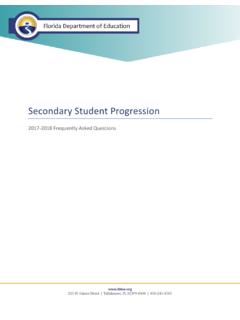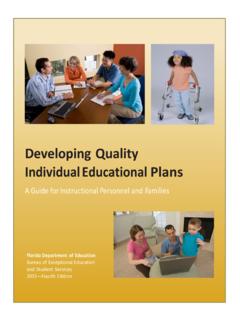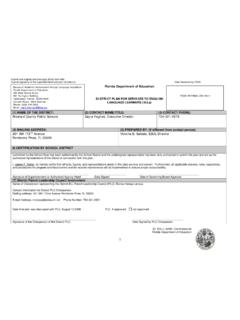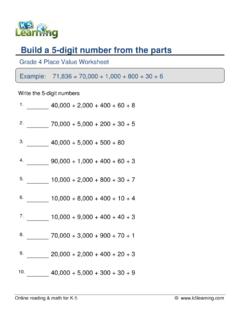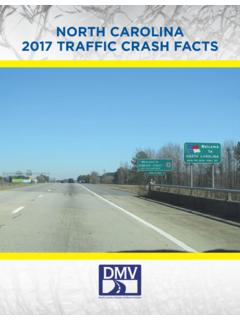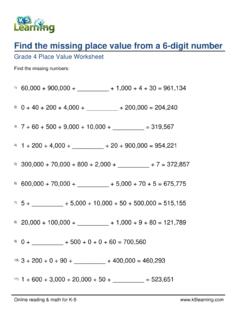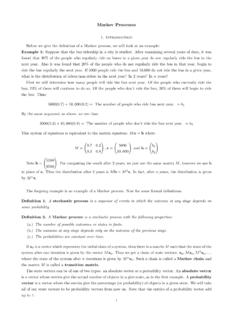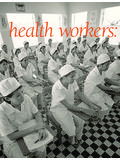Transcription of Critical Teacher Shortage Areas 2019 - fldoe.org
1 Identification of Critical Teacher Shortage Areas Recommended Critical Teacher Shortage Areas This report identifies which certification Areas represent the greatest need among teachers statewide. Using the information provided below, the recommended Critical Teacher Shortage Areas for the 2019-20 school year are as follows: Science-General English Mathematics English for Speakers of Other Languages (ESOL). Science-Physical Reading Technical Education Exceptional Student Education (ESE). The Shortage Areas above represent certification Areas where substantial proportions of teachers who are not certified in the appropriate field are being hired to teach such courses, where significant vacancies exist and where postsecondary institutions do not produce enough graduates to meet the needs of Florida's K-12 student population.
2 This information can be used to determine the current and projected needs of classroom teachers for specific subject Areas in the upcoming school year. The process used to determine these Critical Teacher Shortage Areas is presented below. Background Section , , requires the State Board of Education (SBE) to annually identify Critical Teacher Shortage Areas based on the recommendations of the Commissioner of Education. This statute is accompanied by SBE Rule , Florida Administrative Code, which specifies that the list of Shortage Areas identify high-need content Areas and high-priority location Areas using the following information: 1. The number and percentage of positions in each discipline filled by teachers not certified in the appropriate field;. 2. The annual supply of graduates of state-approved Florida Teacher education programs for each discipline.
3 3. The number and percentage of vacant positions in each teaching discipline; and 4. Critical Teacher Shortage Areas which may be identified pursuant to rules adopted by district school boards. These Areas shall be identified based on consideration of at least the information specified in items 1 through 3 above and submitted to the Department no later than June 1st of each year. Additionally, sections (1)(c) , , and (1)(c) , , include provisions requiring local school districts to incorporate Critical Teacher Shortage Areas into both their grandfathered and performance salary schedules. Determining Shortage Areas The Critical Teacher Shortage Areas for 2019-20 were determined using information provided in Exhibits 3 through 5. The Department used the information in each of the exhibits to create rankings for each measure in Exhibit 1.
4 1 Rankings were then averaged across all measures to produce the final rankings. In Exhibit 1 below, the shaded and bolded subject fields indicate the recommended 2019-20 Critical Teacher Shortage Areas . The final column in Exhibit 1, Final Rank, shows that Science-General was ranked first place with an average rank of English was ranked second and followed by Mathematics, English for Speakers of Other Languages (ESOL), Science-Physical, Reading, and Technical Education as Critical Teacher Shortage Areas . Exhibit 1 Summary of Critical Teacher Shortage Rankings for 2019-20. Rank Based on % of Rank Based on Rank Based on %. Courses Taught by Projected of Completers Teachers Not Certified in Vacancies (as (as reported by the Appropriate Field for reported by Teacher the Course (as reported school preparation Average Final Certification Areas by school districts) districts) programs) Rank Rank Rank Science-General* 5 5 15 1 1.
5 English 1 3 23 4 4. Mathematics 4 4 19 4 4. ESOL* 3 8 16 4 4. Science-Physical* 7 11 11 5 5. Reading 2 9 21 7 7. Technical Education 9 17 6 7 7. ESE* 6 2 25 8 8. Science-Earth & Space 8 20 7 9. Health 10 22 4 10. Business Education 15 18 4 11. Educational Media Specialist 12 19 10 13. Science-Biology 12 12 17 13. Guidance 14 10 18 14. Foreign Languages-Other 13 25 6 16. Foreign Languages-Spanish 19 16 9 16. Computer Science 22 21 4 18. Physical Education 21 13 13 18. Pre-K/Primary Education 17 7 24 20. Drama 20 24 4 20. Agriculture 16 23 12 22. Social Sciences 23 6 22 22. Art 24 15 14 25. 1. The rankings order the data with 1 being the subject area that shows the most need for additional teachers. For example, when looking at Exhibit 5, the subject area with the fewest program completers would be ranked as number 1, but for Exhibit 4 the subject area with the most vacancies would be ranked as number 1.
6 In the case of a tie, all subject Areas are assigned the lowest rank. For example, if three subject Areas tie for third place ( there is no way to distinguish between third, fourth, and fifth place), they would all be assigned fifth place. 2. Rank Based on % of Rank Based on Rank Based on %. Courses Taught by Projected of Completers Teachers Not Certified in Vacancies (as (as reported by the Appropriate Field for reported by Teacher the Course (as reported school preparation Average Final Certification Areas by school districts) districts) programs) Rank Rank Rank Foreign Languages-French 18 26 9 25. Elementary Education 26 1 26 25. Music 25 14 20 26. Notes: Certification Areas that were missing data in one or more of the measures examined were not ranked and excluded from the exhibit. Bolded subject fields indicate 2019-20 Critical Teacher Shortages.
7 * Science-General includes Science and General Science; Science-Physical includes Chemistry and Physics; ESE includes Exceptional Student Education, Speech Correction, Emotionally Handicapped, Hearing Impaired, Mentally Handicapped, Physically Impaired, Specific Learning Disabilities, Speech- Language Impaired, Varying Exceptionalities, Visually Impaired, Autism Spectrum Disorders endorsement, Adaptive Physical Education, and Orientation and Mobility endorsement; and Reading and ESOL include both the certification and the endorsement. Information on Critical Teacher Shortage Areas Data on teachers currently in the workforce and their Areas of certification are presented below to provide context for the recommended Critical Teacher Shortage Areas . This information covers the following: certification Areas in which the majority of teachers are currently certified; the number of courses taught by teachers who were not appropriately certified for the courses they were teaching; the projected number of Teacher vacancies as reported by school districts; and the number of recent completers of state-approved Teacher preparation programs in Florida.
8 Additional information is provided on the number of courses being taught by teachers who were not certified in the appropriate field for the courses they were teaching in high-priority locations. 2 The following exhibits provide information on Teacher supply and demand: Exhibit 2 number of Teacher Certifications Held by Certification Area During 2018-19. Exhibit 3 number of Courses Taught by Teachers Not Certified in the Appropriate Field, by Certification Area During 2017-18. Exhibit 4 number of Current and Projected Vacancies by Certification Area for 2018-19. Exhibit 5 number of Students Completing Teacher Education Programs During 2016-17. Exhibit 6 High-Priority School Locations and Courses Taught by Appropriately Certified Teachers in 2017-18. It is important to note and emphasize that all data are as reported by school districts or Teacher preparation programs.
9 2. Section , , defines high-priority locations as high-density, low-economic urban schools; low-density, low-economic urban schools; low-density, low-economic rural schools; and schools that earned a grade of F or three consecutive grades of D pursuant to s. , 3. Exhibit 2 provides the total number of certifications held by teachers in 2018-19 by certification area. If a Teacher held a certification in multiple subject Areas , the certification is counted once for each subject area. The most common Teacher certification area for the 2018-19 school year was Elementary Education, making up of all certifications. This was closely followed by ESOL at Shortage Areas for 2019-20 are shaded and bolded in the exhibit below. Following Elementary Education and ESOL, the numbers drop off with ESE making up of certifications and Reading and Pre- K/Primary Education making up and of certifications, respectively.
10 The eight recommended Critical Teacher Shortage Areas account for about of all certifications (n=208,143). The complete crosswalk of Certification Subject Codes to Certification Areas can be found in Appendix C. Exhibit 2 number of Teacher Certifications Held by Certification Area - Top Areas for 2018-19. Total number of Percentage of Certification Areas Certifications Certifications Elementary Education 93,017 ESOL* 87,094 ESE* 45,288 Reading* 28,634 Pre-K/Primary Education 20,484 English 19,399 Social Sciences 18,700 Mathematics 17,457 Gifted 13,652 Physical Education 10,342 Science-Biology 6,452 Guidance 6,417 Science-General* 6,254 Foreign Languages-Spanish 5,284 Music 4,595 Business Education 4,531 Art 4,275 Educational Media Specialist 3,576 Early Childhood/Preschool 3,475 Health 3,087 Science-Physical* 3,048 Science-Earth and Space 1,714 School Social Worker 1,472 School Psychologist 1,456 Family and Consumer Sciences 1,192 Technical Education 969 Driver Education 900 Drama 848 Foreign Languages-French 828 Computer Science 625 Agriculture 621 Foreign Languages-Other 554 Statewide Total 416.
